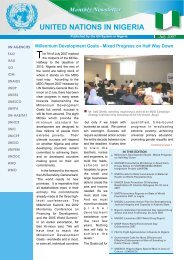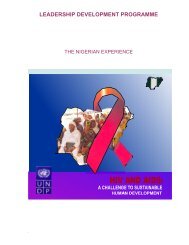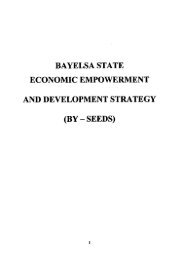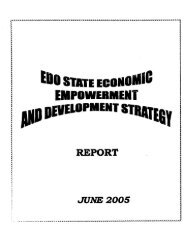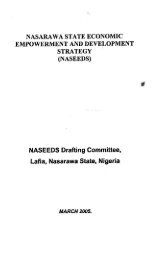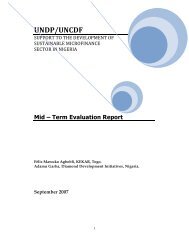Niger Delta Human Development Report - UNDP Nigeria - United ...
Niger Delta Human Development Report - UNDP Nigeria - United ...
Niger Delta Human Development Report - UNDP Nigeria - United ...
You also want an ePaper? Increase the reach of your titles
YUMPU automatically turns print PDFs into web optimized ePapers that Google loves.
A youthful demographic<br />
structure means many<br />
people remain outside of<br />
the working age bracket<br />
and are in their<br />
formative years, when<br />
social investment is<br />
heaviest.<br />
Although life expectancy<br />
in the region is similar<br />
to that in the rest of the<br />
country, it has tended to<br />
be lower in the more<br />
economically deprived<br />
communities.<br />
exacerbate the volatile atmosphere, rather<br />
than promoting the needed transformation.<br />
Population and Demographic<br />
Characteristics Population size and<br />
density<br />
In the 1991 census, the total population of<br />
all nine states of the <strong>Niger</strong> <strong>Delta</strong> was 20.5<br />
million (see table 1.2). This was made up<br />
of 10.133 million males and 10.329 million<br />
females. The projected total population for<br />
2005 is 28.9 million, rising to 39.2 million<br />
by 2015 and 45.7 million by 2020. The<br />
states with the highest population sizes are<br />
Rivers, <strong>Delta</strong>, Akwa Ibom and Imo. With<br />
the possible exception of Bayelsa and Cross<br />
River states, there are probably no<br />
significant differences in population sizes<br />
among the states. Differences do show up<br />
in population densities. The overall<br />
population density for the <strong>Niger</strong> <strong>Delta</strong><br />
region based on the 1991 population is 182<br />
persons per square kilometre. But some<br />
states have densities far above this-e.g. Abia<br />
State (478 per square kilometre), Akwa<br />
Ibom (354 per square kilometre), Imo (481<br />
per square kilometre) and Rivers (307 per<br />
square kilometre). Population distribution<br />
within each state is uneven, particularly in<br />
the states in the core <strong>Niger</strong> <strong>Delta</strong>, where<br />
the fragmented, swampy landscape<br />
constrains human settlements.<br />
Age-sex composition<br />
Based on the 1991 census, there is almost<br />
an even distribution of population between<br />
men and women in the <strong>Niger</strong> <strong>Delta</strong> region.<br />
In some states (Abia, Akwa Ibom, <strong>Delta</strong>,<br />
Edo and Imo), there are more females than<br />
males (see table 1.3). This has implications<br />
for development planning especially in a<br />
situation where gender disparity has been<br />
a major problem. The NDDC Regional<br />
Master Plan, however, reports that there<br />
are more males (54 per cent) than females<br />
(46 per cent) in the <strong>Niger</strong> <strong>Delta</strong> region. If<br />
this is confirmed by the 2006 National<br />
Census, then things may have turned<br />
around. What may not have changed is the<br />
male domination of traditional <strong>Niger</strong>ian<br />
society.<br />
Available information on the age structure<br />
of the population of states in the <strong>Niger</strong><br />
<strong>Delta</strong> region depicts a large segment of<br />
young people below 30 years of age. This<br />
group comprises 62.1 per cent of the<br />
population of the region, compared with<br />
35.8 per cent of adults in the 30- to 69year<br />
age bracket. This demographic feature<br />
has various implications for development<br />
planning and the financing of social<br />
services. A youthful age structure implies<br />
that many people remain outside of the<br />
working age bracket. In the formative<br />
years, social investment rather than<br />
economic investment is required. This<br />
creates an additional dependency burden<br />
for the average family or the economically<br />
active population, and states in the <strong>Niger</strong><br />
<strong>Delta</strong>. The magnitude of such a burden<br />
tends to be greater for impoverished<br />
families or population units that are either<br />
unemployed, under-employed or lack the<br />
benefit of full employment. A<br />
comparatively high proportion of people<br />
below the working age also tends to reduce<br />
labour input per capita and income per<br />
capita.<br />
Fertility, life expectancy and mortality<br />
Available household survey data for 2004<br />
put the average crude birth rate for the<br />
<strong>Niger</strong> <strong>Delta</strong> region at 45.8 per 1,000 people.<br />
The corresponding average natural growth<br />
rate of 3.1 per cent per annum across the<br />
region is, thus, higher than the rate of 2.5<br />
per cent often used by the Government<br />
for estimating the growth rate of rural<br />
population in the country.<br />
There is little empirical data on life<br />
expectancy in the delta. But the best<br />
national estimates, citing figures from 2000,<br />
indicate that average life expectancy is 46.8<br />
years. The present figure may have dropped<br />
to about 43 years because of the economic<br />
deprivations of the intervening years and<br />
the cumulative impact of HIV&AIDS. It<br />
is assumed that life expectancy in the region<br />
is similar to that in the rest of the country.<br />
Nevertheless, even in the best of times,<br />
life expectancy has tended to be lower in<br />
the more economically deprived<br />
communities, such as those in the most<br />
swampy and least accessible parts of the<br />
core <strong>Niger</strong> <strong>Delta</strong>. Although hard<br />
longitudinal data are also generally lacking<br />
on specific maternal and infant mortality<br />
rates, the crude death rate for the <strong>Niger</strong><br />
<strong>Delta</strong> region was 14.7 per 1,000 people in<br />
2003 (CPED 2003). Low life expectancy,<br />
of course, is also a reflection of high<br />
mortality rates. For instance, against the life<br />
24 NIGER DELTA HUMAN DEVELOPMENT REPORT



